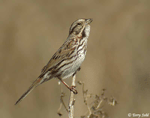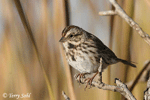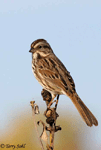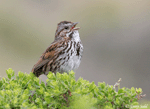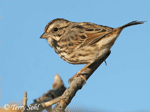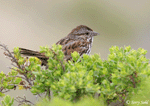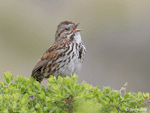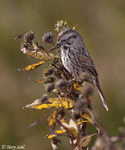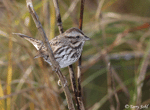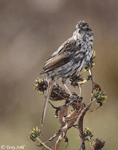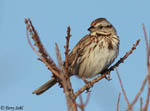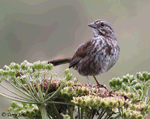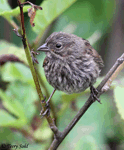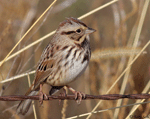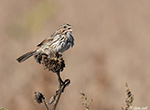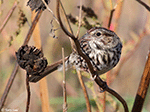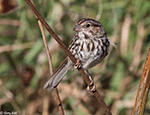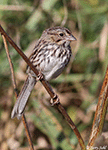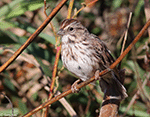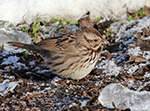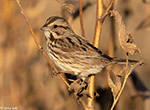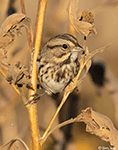| Length: 5.5 to 7 inches | Wingspan: 8.5 to 11 inches | Seasonality: Summer / All Seasons |
| ID Keys: Streaks on chest with central blotch, long tail, striped face | ||
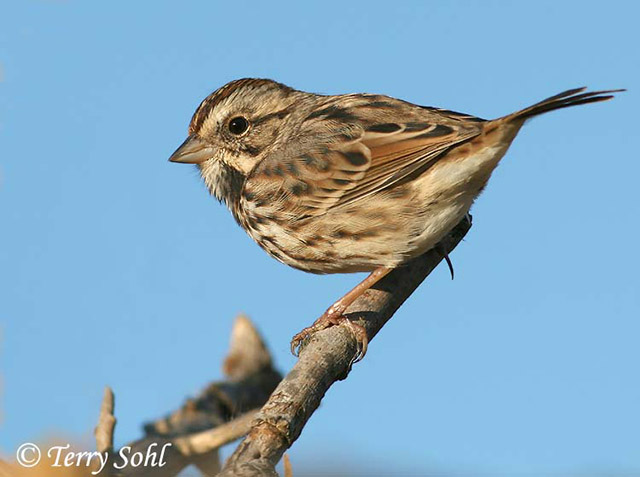 The Song Sparrow is one of
the most familiar birds in parts of the United States, although its habit of
using dense vegetation may occasionally mask its presence. They are quite
adaptable, preferring habitats with thick cover, but adapting to a wide variety
of brushy habitats. Song Sparrows
may vary greatly in size and coloration over their wide range in North
America. Over 30 different sub-species have been recognized. The songs are
similarly variable, with different "dialects" found in different parts of North
America (and substantial variation in individual songs as well).
The Song Sparrow is one of
the most familiar birds in parts of the United States, although its habit of
using dense vegetation may occasionally mask its presence. They are quite
adaptable, preferring habitats with thick cover, but adapting to a wide variety
of brushy habitats. Song Sparrows
may vary greatly in size and coloration over their wide range in North
America. Over 30 different sub-species have been recognized. The songs are
similarly variable, with different "dialects" found in different parts of North
America (and substantial variation in individual songs as well).
Habitat:
Habitats varies greatly, although they are generally found near brush and thickets. Habitats may include fencerows, streamsides, brushy fields, forest edges and openings, and residential areas.
Diet:
The summer diet consists of many insects and spiders, while the winter diet consists primarily of the seeds of grasses and weeds. Will also feed on assorted berries, while those near coastal wetlands may feed on small mollusks and crustaceans.
Behavior:
Often skulks in thickets and brush, but males may be conspicuous when singing from higher perches. Primarily forages on the ground, but also sometimes in trees and shrubs.
Nesting:
May through July in South Dakota. The nest of a Song Sparrow is constructed in thick cover, most often on the ground, but sometimes low in a bush or a tree. The nest is placed in an area that offers cover and protection, often next to a clump of grass or vegetation or the base of a small shrub. The nest itself is a cup built of grasses, weed stems, and strips of bark, lined with hair, rootlets, or finer grasses. The female lays between 2 and 6 eggs, and she alone incubates them. The young hatch after 12 to 14 days, and fledge from the nest in another 10 to 12 days after hatching.
Song:
The song of a Song Sparrow begins with multiple clear whistled notes, spaced with clear but short intervals, and ending with variable, multi-tone buzzing or trill notes. Just as Song Sparrow plumages vary widely across their North American Range, the song of a Song Sparrow also has unique geographic characteristics. While a birder can generally identify the culprit as a Song Sparrow no matter where it may be found, the details of the songs vary. Song Sparrows also have short call notes.
- Click here to hear the song of a Song Sparrow from New Hampshire1
- Click here to hear the (less common) call notes of a Song Sparrow2
- Click here to hear the (more common) crisp call notes of a Song Sparrow3
- Click here to hear the song of a Song Sparrow from Minnesota (similar to commonly heard songs in South Dakota)4
Migration:
Summers throughout the U.S. and Canada. Winters through most of the U.S. and near the coastlines in Canada. In South Dakota, they are very common as breeding birds in the summer, and in migration. In winter, a few birds may remain (although I rarely run across them in the winter months).
Interactive eBird map:
Click here to access an interactive eBird map of Song Sparrow sightings
Similar Species:
Song Sparrows could be confused with multiple other "striped flank" sparrows. During migration, all of these sparrows could potentially be found in mixed foraging flocks, further challenging a birder in the field. Note that one feature characteristic of a Song Sparrow is a central dark spot on the chest (a feature also shared by the American Tree Sparrow). Otherwise, the following provides a summary of key characteristics and identification features of other sparrows that could be confused with a Song Sparrow.
- Lincoln's Sparrow - The characteristics of the streaking is one of the best ways to differentiate between Song Sparrows and Lincoln's Sparrows. Song Sparrows have broad, bold streaks, while Lincoln's Sparrows have very fine streaks. Lincoln's Sparrows also have a buffy color on their flanks and cheeks that contrasts with a white belly and throat.
- Savannah Sparrow - The streaking on a Savannah Sparrow is somewhat finer than that of a Song Sparrow (although not as fine as a Lincoln's Sparrow), and lacks the central breast spot of the Song Sparrow. Savannah Sparrows also typically have a yellowish tone on the lore in front of the eye (lacking on a Song Sparrow), and have a more delicate looking bill than a Song Sparrow.
- Vesper Sparrow - Vesper Sparrows have finer streaking than a Song Sparrow and lack the central breast spot. Vesper Sparrows also have an obvious, bold white eye ring that differentiates them from the other sparrows listed here. They also have a smaller bill, and white outer tail feathers (often obvious if a bird is flushed).
- Fox Sparrow - Fox Sparrows are the one sparrow listed here that have streaks as broad as a Song Sparrow, and in fact, Fox Sparrows often appear to be more heavily streaked. Fox Sparrows migrating through South Dakota generally appear to have a warmer, rusty color overall, with the streaks on the underparts noticeably more "warm" in tone than those on a Song Sparrow. Habit is also an key identification feature of Fox Sparrows, as they are typically seen on the ground with a characteristic scratching through leaf litter in search of prey.
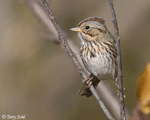 |
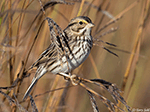 |
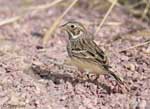 |
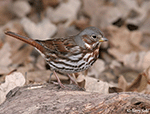 |
| Lincoln's Sparrow | Savannah Sparrow | Vesper Sparrow | Fox Sparrow |
Status:
Song Sparrows will use a wide variety of scrubby habitats, and have adapted well to human modified landscapes. They are found across a very broad geographic area, are common in many parts of that range, and overall numbers are generally stable. The IUCN currently lists the Song Sparrow as a species of "least concern".
Bird Feeders:
Will attend feeders for a wide variety of food items, including sunflower seeds, safflower, cracked corn, peanuts, or millet. They primarily feed on the ground, and would most often be found below feeders, foraging for fallen seeds. They will also feed directly from a platform feeder.
Further Information:
Photo Information:
October 15th, 2005 - Atkin's Slough near Tea, in Lincoln County, South Dakota - Terry Sohl
Additional Photos:
Click on the image chips or text links below for additional, higher-resolution Song Sparrow photos.
Audio File Credits:
- 1Christopher McPherson. Recorded in Hillsborough County, New Hampshire on February 29th, 2020. Original recording and information available from xeno-canto.
- 2James Link. Recorded in Jefferson County, Washington on June 28th, 2020. Original recording and information available from xeno-canto.
- 3Paul Marvin. Recorded in San Diego County, California on August 21st, 2020. Original recording and information available from xeno-canto.
- 4Greg Irving. Recorded in Sherburne National Wildlife Refuge in Minnesota on July 29th, 2018. Original recording and information available from xeno-canto.
Click on the map below for a higher-resolution view |
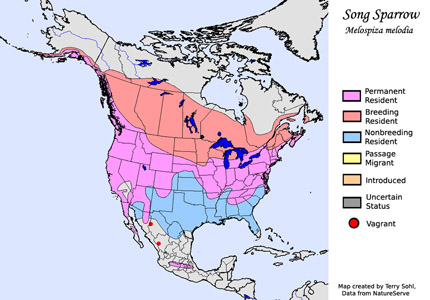 |
| South Dakota Status: Common summer breeding resident in appropriate habitat throughout the state. Rare in the winter, most common in the southern part of the state. |
Additional Song Sparrow Photos
Click for a higher-resolution version of these photos
